Description 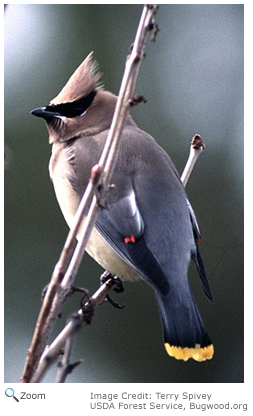 The cedar waxwing is brown on top and pale yellow on its belly. It has a crest of feathers on its head and a black mask lined with white on its face. The cedar waxwing has black legs and feet and a short black bill. It has darker gray wings with a short waxy red tip. Its tail has a yellow tip. The cedar waxwing is brown on top and pale yellow on its belly. It has a crest of feathers on its head and a black mask lined with white on its face. The cedar waxwing has black legs and feet and a short black bill. It has darker gray wings with a short waxy red tip. Its tail has a yellow tip.
Some cedar waxwings in the northeast United States and southeast Canada have an orange tip on their tails. This is caused by their having eaten the berries of an introduced species of honeysuckle, Morrow's honeysuckle, while their tail feathers were growing. Male and female cedar waxwings look alike.
Range 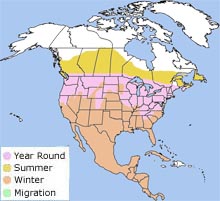 The cedar waxwing's breeding range runs from the southern half of Canada to the northern half of the United States. The cedar waxwing's winter range stretches from the United States and Mexico south to Panama. The cedar waxwing's breeding range runs from the southern half of Canada to the northern half of the United States. The cedar waxwing's winter range stretches from the United States and Mexico south to Panama.
Habitat 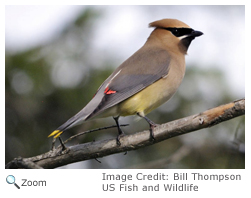 The cedar waxwing lives in open woodlands, orchards, and residential areas, especially those with fruit-bearing trees and bushes. The cedar waxwing lives in open woodlands, orchards, and residential areas, especially those with fruit-bearing trees and bushes.
|
|
Life Cycle 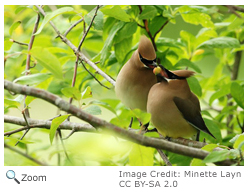 Mating season begins in late spring and runs through late summer. The male courts a female by doing a hopping dance and passing berries or pieces of fruit to the female. If the female is interested, she does a hopping dance and passes the fruit or berry back to the male! The pair may do this a number of times in a row! After pairs form, the female chooses a nest site. The nest is cup-shaped and made of bark, twigs, moss, and grass. The nest is usually made in a conifer tree. Mating season begins in late spring and runs through late summer. The male courts a female by doing a hopping dance and passing berries or pieces of fruit to the female. If the female is interested, she does a hopping dance and passes the fruit or berry back to the male! The pair may do this a number of times in a row! After pairs form, the female chooses a nest site. The nest is cup-shaped and made of bark, twigs, moss, and grass. The nest is usually made in a conifer tree.
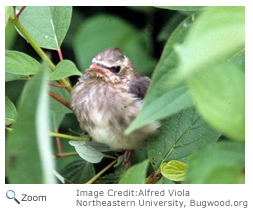 The female cedar waxwing lays four to six eggs. She incubates the eggs for about 12 days. The male brings her food and guards the nest while she incubates the eggs. The chicks are born blind and naked. Both parents feed the chicks. The chicks fledge in about two weeks. Both parents continue to feed them for 6-10 days after they fledge. The female cedar waxwing lays four to six eggs. She incubates the eggs for about 12 days. The male brings her food and guards the nest while she incubates the eggs. The chicks are born blind and naked. Both parents feed the chicks. The chicks fledge in about two weeks. Both parents continue to feed them for 6-10 days after they fledge.
Behavior
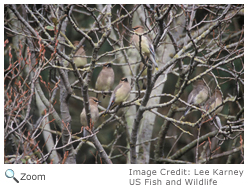 Cedar waxwings are very social birds. They are non-territorial and often groom each other. They travel in flocks of 40 or more birds. They often appear in a spot with a good crop of berries. When they have eaten all the berries, they move on! Cedar waxwings are very social birds. They are non-territorial and often groom each other. They travel in flocks of 40 or more birds. They often appear in a spot with a good crop of berries. When they have eaten all the berries, they move on!
|